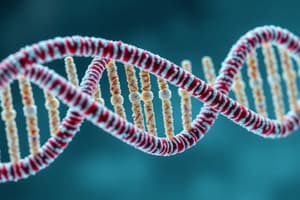Podcast
Questions and Answers
Which type of DNA supercoiling facilitates transcription and translation?
Which type of DNA supercoiling facilitates transcription and translation?
- Positive supercoiling
- Negative supercoiling (correct)
- Neutral supercoiling
- Supercoiling does not affect transcription and translation
Which type of DNA conformation is believed to play a role in gene expression regulation?
Which type of DNA conformation is believed to play a role in gene expression regulation?
- All of the above
- B-DNA
- Z-DNA (correct)
- A-DNA
Which type of DNA compaction involves the attachment of non-histone proteins?
Which type of DNA compaction involves the attachment of non-histone proteins?
- Acetylation
- Higher-order structures
- Nucleosomes
- Deacetylation (correct)
What is the term used to describe the breaking of hydrogen bonds between strands of DNA?
What is the term used to describe the breaking of hydrogen bonds between strands of DNA?
Which type of supercoiling facilitates transcription and translation?
Which type of supercoiling facilitates transcription and translation?
What is the term used to describe the DNA-protein complex present in the nuclei of eukaryotic cells during interphase?
What is the term used to describe the DNA-protein complex present in the nuclei of eukaryotic cells during interphase?
Which type of DNA conformation is left-handed?
Which type of DNA conformation is left-handed?
What is the function of negative supercoiling in DNA?
What is the function of negative supercoiling in DNA?
What is the role of histone proteins in eukaryotic chromosomes?
What is the role of histone proteins in eukaryotic chromosomes?
Flashcards are hidden until you start studying
Study Notes
Key Concepts in DNA and Genome Structure
- Phosphodiester bonds link nucleotides in DNA from 5' to 3'.
- DNA is double-stranded, with antiparallel strands and complementary base pairs.
- Purines and pyrimidines form hydrogen bonds in base pairing, with pyrimidines forming three hydrogen bonds.
- DNA forms a right-handed double helix, with a sugar-phosphate backbone on the outside and bases perpendicular to the helix axis.
- DNA can exist in different conformations, including A-DNA, B-DNA, and Z-DNA.
- DNA can become supercoiled, with negative supercoiling facilitating transcription and translation and positive supercoiling hindering these processes.
- Denaturation of DNA occurs through heat or alkaline ionization, breaking hydrogen bonds between strands.
- RNA is more versatile than DNA due to the presence of a 2'-OH group.
- Genomes are composed of genes, chromosomes, and non-coding DNA.
- Eukaryotic chromosomes are visible during cell division and are associated with histone and non-histone proteins.
- Chromatin is the DNA-protein complex present in the nuclei of eukaryotic cells during interphase.
- Compacting DNA involves nucleosomes, higher-order structures, and the attachment of non-histone proteins, with acetylation and deacetylation affecting gene expression.
Key Concepts in DNA and Genome Structure
- Phosphodiester bonds link nucleotides in DNA from 5' to 3'.
- DNA is double-stranded, with antiparallel strands and complementary base pairs.
- Purines and pyrimidines form hydrogen bonds in base pairing, with pyrimidines forming three hydrogen bonds.
- DNA forms a right-handed double helix, with a sugar-phosphate backbone on the outside and bases perpendicular to the helix axis.
- DNA can exist in different conformations, including A-DNA, B-DNA, and Z-DNA.
- DNA can become supercoiled, with negative supercoiling facilitating transcription and translation and positive supercoiling hindering these processes.
- Denaturation of DNA occurs through heat or alkaline ionization, breaking hydrogen bonds between strands.
- RNA is more versatile than DNA due to the presence of a 2'-OH group.
- Genomes are composed of genes, chromosomes, and non-coding DNA.
- Eukaryotic chromosomes are visible during cell division and are associated with histone and non-histone proteins.
- Chromatin is the DNA-protein complex present in the nuclei of eukaryotic cells during interphase.
- Compacting DNA involves nucleosomes, higher-order structures, and the attachment of non-histone proteins, with acetylation and deacetylation affecting gene expression.
Key Concepts in DNA and Genome Structure
- Phosphodiester bonds link nucleotides in DNA from 5' to 3'.
- DNA is double-stranded, with antiparallel strands and complementary base pairs.
- Purines and pyrimidines form hydrogen bonds in base pairing, with pyrimidines forming three hydrogen bonds.
- DNA forms a right-handed double helix, with a sugar-phosphate backbone on the outside and bases perpendicular to the helix axis.
- DNA can exist in different conformations, including A-DNA, B-DNA, and Z-DNA.
- DNA can become supercoiled, with negative supercoiling facilitating transcription and translation and positive supercoiling hindering these processes.
- Denaturation of DNA occurs through heat or alkaline ionization, breaking hydrogen bonds between strands.
- RNA is more versatile than DNA due to the presence of a 2'-OH group.
- Genomes are composed of genes, chromosomes, and non-coding DNA.
- Eukaryotic chromosomes are visible during cell division and are associated with histone and non-histone proteins.
- Chromatin is the DNA-protein complex present in the nuclei of eukaryotic cells during interphase.
- Compacting DNA involves nucleosomes, higher-order structures, and the attachment of non-histone proteins, with acetylation and deacetylation affecting gene expression.
Studying That Suits You
Use AI to generate personalized quizzes and flashcards to suit your learning preferences.




